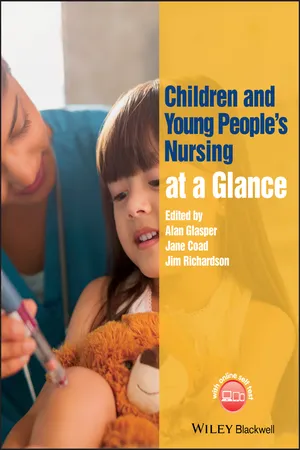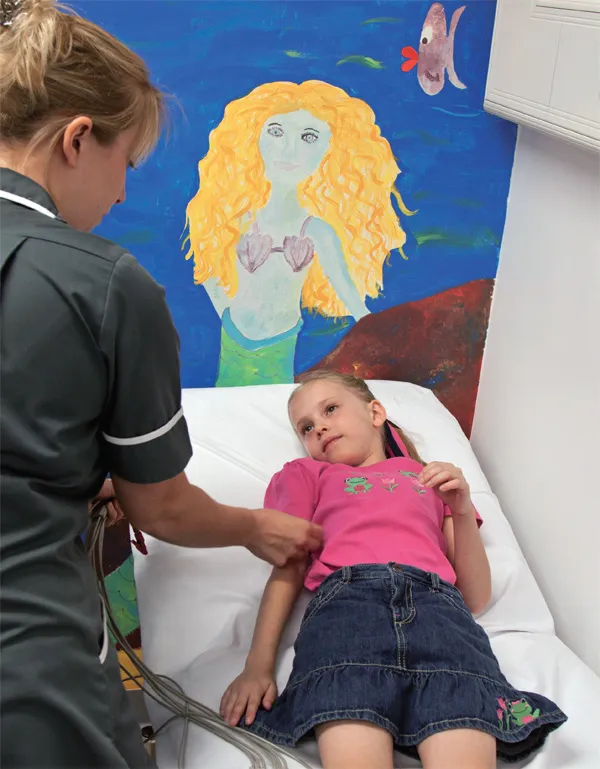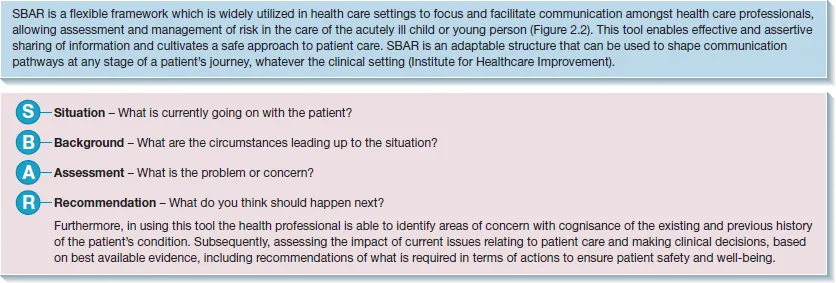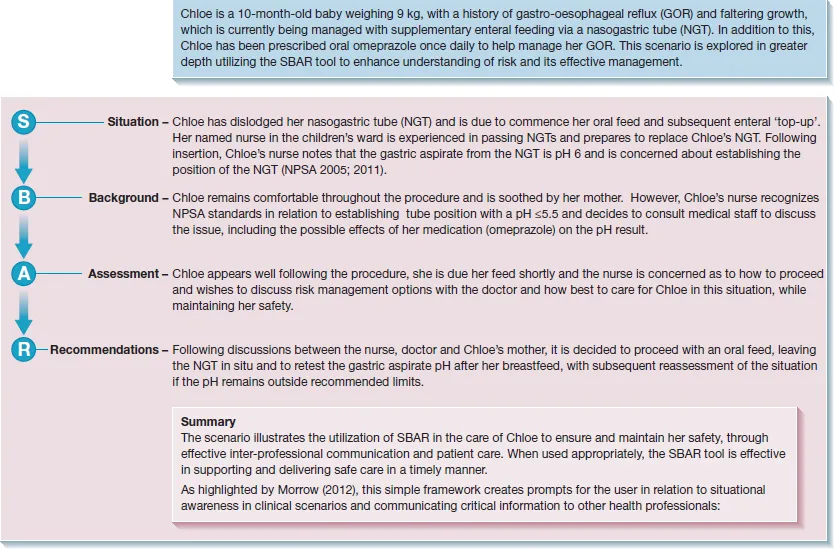
eBook - ePub
Children and Young People's Nursing at a Glance
- English
- ePUB (mobile friendly)
- Available on iOS & Android
eBook - ePub
Children and Young People's Nursing at a Glance
About this book
Children and Young People's Nursing at a Glance, is the perfect companion for study and revision for pre-registration children's nursing students from the publishers of the market-leading at a Glance series. Divided into seven sections it explores assessment and screening, working with families, the newborn infant, the developing child, child health policy, nursing the sick child and young person and chronic and life-limiting conditions.
This comprehensive book is an invaluable resource for pre-registration nursing students as well as newly qualified nurses wanting to consolidate and expand their knowledge of children and young people's nursing.
- Breaks down complex aspects of child health care in an accessible and un-intimidating way
- The perfect revision and consolidation textbook
- Linked closely with the NMC standards for pre-registration nursing education, and the essential skills clusters framework
- Highly visual colour presentation, with approximately 130 illustrations
- Includes boxes, summary boxes, key points and recommendations for practice to improve the learning experience
- Supported by a companion website featuring over 500 interactive multiple choice questions (www.ataglanceseries.com/nursing/children)
- Available in a range of digital formats - perfect for 'on the go' study and revision
Frequently asked questions
Yes, you can cancel anytime from the Subscription tab in your account settings on the Perlego website. Your subscription will stay active until the end of your current billing period. Learn how to cancel your subscription.
No, books cannot be downloaded as external files, such as PDFs, for use outside of Perlego. However, you can download books within the Perlego app for offline reading on mobile or tablet. Learn more here.
Perlego offers two plans: Essential and Complete
- Essential is ideal for learners and professionals who enjoy exploring a wide range of subjects. Access the Essential Library with 800,000+ trusted titles and best-sellers across business, personal growth, and the humanities. Includes unlimited reading time and Standard Read Aloud voice.
- Complete: Perfect for advanced learners and researchers needing full, unrestricted access. Unlock 1.4M+ books across hundreds of subjects, including academic and specialized titles. The Complete Plan also includes advanced features like Premium Read Aloud and Research Assistant.
We are an online textbook subscription service, where you can get access to an entire online library for less than the price of a single book per month. With over 1 million books across 1000+ topics, we’ve got you covered! Learn more here.
Look out for the read-aloud symbol on your next book to see if you can listen to it. The read-aloud tool reads text aloud for you, highlighting the text as it is being read. You can pause it, speed it up and slow it down. Learn more here.
Yes! You can use the Perlego app on both iOS or Android devices to read anytime, anywhere — even offline. Perfect for commutes or when you’re on the go.
Please note we cannot support devices running on iOS 13 and Android 7 or earlier. Learn more about using the app.
Please note we cannot support devices running on iOS 13 and Android 7 or earlier. Learn more about using the app.
Yes, you can access Children and Young People's Nursing at a Glance by Alan Glasper, Jane Coad, Jim Richardson, Alan Glasper,Jane Coad,Jim Richardson in PDF and/or ePUB format, as well as other popular books in Medicine & Pedriatic Nursing. We have over one million books available in our catalogue for you to explore.
Information

Part 1
Assessment and screening

1
Assessment of the child

Figure 1.1 Assessment of the child
Assessment is the collection of data, both subjective and objective, which aims to achieve a complete picture of the child’s health status. Good assessment is a combination of the interpretation of physical data with the information gained from observation of the child and family and from listening to them.
Interviewing – history taking
Gaining the trust of the child and family is an essential element in developing of an effective therapeutic relationship. Introducing yourself to the child and family with explanations of expected outcomes will put the child and family at ease. Age appropriate language should be used. Questions should be directed at both the child and parent. Young people should have an opportunity to talk in private if they wish. When taking a history, a structured approach should be used. This needs to include:
- Presenting complaint
- History of presenting complaint
- Past medical history (birth and neonatal history in infants and young children), immunizations, illnesses and hospitalizations
- Allergies
- Current medication
- Developmental history
- Family history
- Social history – nursery, school.
Observation – subjective data
Subjective data are what the child and parent say along with the visual information gained from the initial encounter with the child and family or while obtaining objective data (physical examination and recording of vital signs). This includes noting:
- The colour of the child: are they pale, mottled, cyanosed, jaundiced, flushed
- Behaviour: alert, crying, agitated, combative, lethargic, drowsy
- Interaction with parents/carers/strangers
- Interaction with environment, wanting to play or sleepy
- Position: normal, floppy or stiff
- The general appearance of the child: e.g. unkempt or clean
- Obvious birthmarks, bruises or rashes
- Dysmorphic features.
Measuring – objective data
All infants and children require a baseline physical assessment. This is a multifaceted process and some aspects are common to all children who require assessment of their health status. The physical assessment is concerned with the analysis and interpretation of data. Privacy and dignity should be maintained during this process. Consent should be obtained prior to undertaking a physical assessment.
Physical assessment includes:
- Basic physical recordings of temperature, pulse rate, respiratory rate, oxygen saturation and blood pressure
- Respiratory assessment, rate of breathing, depth of breathing, noise of breathing, presence of cough, chest movement, nasal flaring, use of other accessory muscles, child’s colour, ability to speak/feed, position of the child, peak flow and oxygen saturation level
- Heart rate including pulse volume
- Capillary refill time
- Neurological status using Glasgow coma scale or AVPU
- Level of hydration: obvious signs of dehydration include sunken anterior fontanelle, dull sunken eyes, dry oral mucosa, lethargy, weak cry, decreased urinary output
- Weight
- Height/length
- Head circumference
- Skin assessment using recognized pressure risk assessment tool
- Urinalysis.
All findings need to be documented as they are a legal record of the nursing assessment, the foundation on which care is planned and the basis of communication with multidisciplinary team.
Summary
Assessment is a dynamic continuous process that needs to include the child’s and parentor carer’s perspectives. Observation is as essential as physical assessment and good communication skills are important.
2
SBAR framework

Figure 2.1 SBAR framework

Figure 2.2 Simulated scenario using the SBAR tool
Inter-professional working
SBAR is a valuable communication tool when used either uniprofessionally or inter-professionally. For example during clinical placement the practice mentor may utilise this SBAR tool to provide feedback on the nursing student’s ability to prioritise using this flexible framework, when reporting on a patients’ condition and on their theoretical knowledge and problem-solving skills.
Additionally, effective understanding of collaboration and inter-professional working are essential elements within healthcare education and practice. During simulated inter-professional learning sessions, nursing and medical students are encouraged to reflect upon this situational briefing tool, which guides them to communicate important information in a predictable ...
Table of contents
- Cover
- Table of Contents
- Preface
- Part 1: Assessment and screening
- Part 2: Working with families
- Part 3: The newborn infant
- Part 4: The developing child
- Part 5: Child heath policy
- Part 6: Nursing the sick child and young person
- Part 7: Chronic and life-limiting conditions
- References and further reading
- Index
- End User License Agreement